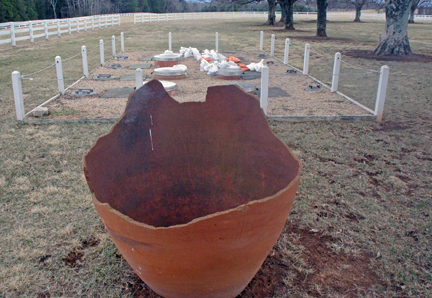We spent the weekend searching for a bit of the country Georgia in America. We had to travel about three hours from central Maryland to central Virginia. We visited Castle Hill Cider and discovered an outdoor marani with several buried qvevri. The qvevri were different sizes and were produced in Georgia. One broke during transport and stands guard over the marani. Other pieces of the broken qvevri are in the tasting room. Staff use the broken pieces to show visitors the wax lining on the inside of the terra cotta qvevri.

A broken qvevri stands guard over the marani holding several buried qvevri.
Castle Hill Cider in Keswick, Virginia may be the only cidery in the world that makes a cider in a qvevri. Pippin apples are crushed and just the juice is placed in the qvevri to ferment. The cider remains in qvevri for a few months. The name of the cider is Levity and it has a light yellow color. There is apple on the aroma and taste, but it is less pronounced than other ciders not made in qvevri. We noticed that the Levity was more complex than the other ciders. There were also hints of honey on the aroma and taste and some minerality on the finish. Stuart Madany, production manager, is investigating using more tannic apples in the future.
Another Georgia connection was discovered at Morais Vineyard and Winery in Bealeton, Virginia. Our first wine tasted was Select 2012. This light yellow wine was made entirely of Rkatsiteli grapes. The winemaker sourced the Rkatsiteli grapes form Horton Vineyards, also in Virginia. Somewhere in the back of my mind, I seem to remember being told that Horton purchased his Rkatsiteli vines from Dr. Frank in the Finger Lakes. Before coming to America, Dr. Frank managed a vineyard of Rkatsiteli in Georgia.
The Morais Select offered a floral aroma. The taste had floral hints along with peach and citrus. The fruity finish lingered especially peach. The wine was made in modern stainless steel tanks rather than traditional qvevri.
There is a growing fascination with Georgian grape varieties and traditional qvevri wines. I spoke to an enthusiastic home winemaker last week that once to bury several qvevri in upstate Pennsylvania and make qvevri wines. Once he tasted some qvevri-made white wines, he became hooked on the idea of making white wines in qvevris.
Cheers,
Terry
-1.5in.jpg)


In Search of a Bit of Georgia in America
We spent the weekend searching for a bit of the country Georgia in America. We had to travel about three hours from central Maryland to central Virginia. We visited Castle Hill Cider and discovered an outdoor marani with several buried qvevri. The qvevri were different sizes and were produced in Georgia. One broke during transport and stands guard over the marani. Other pieces of the broken qvevri are in the tasting room. Staff use the broken pieces to show visitors the wax lining on the inside of the terra cotta qvevri.
A broken qvevri stands guard over the marani holding several buried qvevri.
Castle Hill Cider in Keswick, Virginia may be the only cidery in the world that makes a cider in a qvevri. Pippin apples are crushed and just the juice is placed in the qvevri to ferment. The cider remains in qvevri for a few months. The name of the cider is Levity and it has a light yellow color. There is apple on the aroma and taste, but it is less pronounced than other ciders not made in qvevri. We noticed that the Levity was more complex than the other ciders. There were also hints of honey on the aroma and taste and some minerality on the finish. Stuart Madany, production manager, is investigating using more tannic apples in the future.
Another Georgia connection was discovered at Morais Vineyard and Winery in Bealeton, Virginia. Our first wine tasted was Select 2012. This light yellow wine was made entirely of Rkatsiteli grapes. The winemaker sourced the Rkatsiteli grapes form Horton Vineyards, also in Virginia. Somewhere in the back of my mind, I seem to remember being told that Horton purchased his Rkatsiteli vines from Dr. Frank in the Finger Lakes. Before coming to America, Dr. Frank managed a vineyard of Rkatsiteli in Georgia.
The Morais Select offered a floral aroma. The taste had floral hints along with peach and citrus. The fruity finish lingered especially peach. The wine was made in modern stainless steel tanks rather than traditional qvevri.
There is a growing fascination with Georgian grape varieties and traditional qvevri wines. I spoke to an enthusiastic home winemaker last week that once to bury several qvevri in upstate Pennsylvania and make qvevri wines. Once he tasted some qvevri-made white wines, he became hooked on the idea of making white wines in qvevris.
Cheers,
Terry